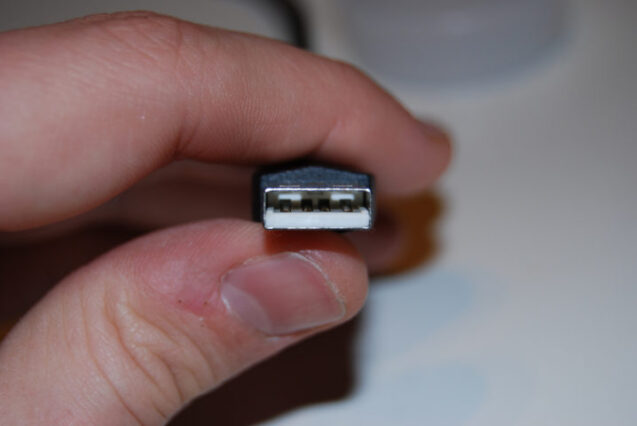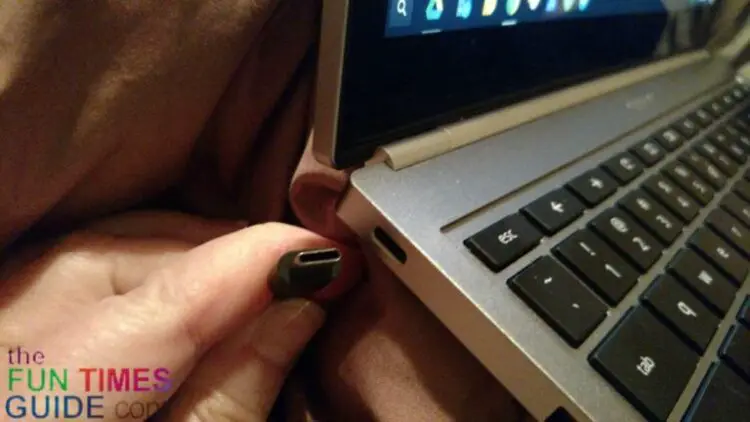Apple disrupted industry trends with its 2015 MacBook. The weight and thin profile were expected. However, it was the introduction and inclusion of just one USB Type C port on the laptop that came as a big surprise for everyone.
These photos show the traditional USB Type A connector (top photo) next to the all-new USB Type C connector (bottom photo):
So, what is it about USB C that makes it so interesting?
Well, for starters, all manufacturers are moving to USB C (not just Apple) — which means we’re closer than ever to having one standard cable to charge all of our devices!
The dream of a 1-cable future is looking a little more real now that newer, better USB Type C ports are here. — Mashable
Wondering why Apple chose this over its super-fast and versatile Lightning and Thunderbolt ports?
The answer is simple: USB Type C is the future.
Here’s why you’re going to love this new technology — and why you should look for USB C on the next gadgets you buy.
What Is USB C & How Does It Compare To Other Types Of USB?
It may have a long and complicated name, but USB Type C is quite possibly the most important bit of technology to hit the tech industry in years.
It will fundamentally change the way we use our electronic gadgets.
To understand what it is, let’s go through all USB types:
- USB Type A
— the original, large rectangular shaped USB connector that you can find almost everywhere nowadays. It’s used most commonly in flash thumb drives and external hard drives.
- USB Type B
— the square-shaped USB connector has become a fading standard. It can be seen on the backs of printers.
- Micro USB
— this flattened triangular shaped USB connector is small, fast, and convenient. If you own a smartphone or tablet (other than iPad or iPhone), then you’ve seen this. It been the most common form of USB for years now.
- Mini USB
— this chunky triangular shaped USB connector is another rapidly dying format. You may have seen it on devices such as GPS units and some external hard drives and digital cameras.
The all new USB Type C is designed to replace them all!
It combines the best from all USB types (like the power and speed of Type A USB and the size of Micro USB) to form one incredible connector.
Why USB Type C Is The Best
For starters, USB C launched with USB 3.1 — which increased bandwidth to a whole new level. For example, USB 3.1 goes up to 10Gbps, which is roughly 1,250 megabytes per second. (That’s per second!)
See the 3 major USB standards — with USB 3.1 being the newest.
And it’s future-proof.
It’s not just about speed though. USB Type C can draw more power. For example, USB 3.0 could handle up to 900mA for up to 4.5 watts of power. But USB C goes up to 5,000mA for up to 100W of power — which is more than even the largest laptops typically need.
That means USB Type C will not only charge your devices faster, but it will also be able to power your laptops and other devices that have big power requirements. To put this into perspective: a regular 15-inch laptop draws about 60 to 65 watts of power — which you can easily power with a Type C connector. (This is why Apple decided to forego a separate power connector for the new ultra-thin Macbook.)
Even more reasons to love the USB Type C connector:
- It doubles as an extra port when not charging. That means USB C will turn your phone into a battery pack to charge other gadgets!
- It can be used to connect a number of devices. You can connect external displays, hard drives, smartphones, and more. This single port will take care of power, display output, transfer data, and other functions.
- It supports bi-directional power flow. Traditionally, USB ports have supported unidirectional flow of power — from the host to the peripheral device. (For example, charging your smartphone or tablet from your laptop computer’s USB port.) However, with USB C, power can be supplied by either of the 2 connected devices. This opens up a lot of new possibilities.
- It’s reversible. That means there isn’t a ‘right’ way or a ‘wrong’ way to insert it. So you won’t be fumbling around the USB port and cursing after trying to put it in upside down.
- It’s backwards compatible. However, you will need USB Type C adapters to connect to USB 2 and USB 3 ports.
- It’s super durable. Type C connectors are far more durable than their predecessors. The specification states the durability to be around 10,000 cycles of insertion & removal from ports. The specification for the previous USB standard was only about 1,500 cycles.
This video shows the durability of the USB Type-C connector:
The Future Is Here
Clearly, USB C is here to stay. Here’s some more evidence of that:
- Apple has joined the bandwagon.
- Google’s Chromebook Pixel includes 2 USB Type C ports.
- Nokia’s N1 tablet was the first to feature a USB C port.
- USB C is now readily available on smartphones and tablets.
- Major computer manufacturers are now introducing devices with USB Type C ports.
So yes, the future is already here.
With more devices in the pipeline, it’s easy to imagine a future in which monitors, printers, speakers, and almost every other device can be powered using USB C. In fact, manufacturers may even drop their incompatible chargers for a single Type-C connector.
USB is ubiquitous. And with the introduction of USB Type C, it’s now been designed in such a way that it is sure to retain its title as the world’s favorite connector.
For now, suffice it to say that USB C is much faster, more powerful, slimmer, and much more effective than all USB types that preceded it.
The Bottom Line…
In the immediate future, most computers and devices that we are used to having charged will have both USB Type C ports and larger USB Type A ports.
If you haven’t already, it’s time to get on the USB C connector bandwagon — so you’ll be able to slowly transition all of your devices seamlessly.
But read this before you buy a cheap USB C cable!
I got my first computer in 1986 and immediately started writing, saving documents, and organizing my entire life on it. Thus began my love affair with gadgets and all things tech. I built my first website in 1998 in old-school HTML code — before websites were "a thing". Blogs weren't invented yet. It was the same year that Google was born. My husband and I created TheFunTimesGuide.com in 2004 — before YouTube, Twitter, Reddit, and Mashable were launched. That was the year Facebook started and 'blog' was the Word of the Year according Merriam-Webster. Ever since then, anytime a new electronic gadget hits the market… I have to have it. (My husband's impulsive nature to try out every new tech gadget invented is even worse than mine!) When I'm not trying out fun new tech gadgets, you'll find me at the corner of Good News & Fun Times as publisher of The Fun Times Guide (32 fun & helpful websites).







